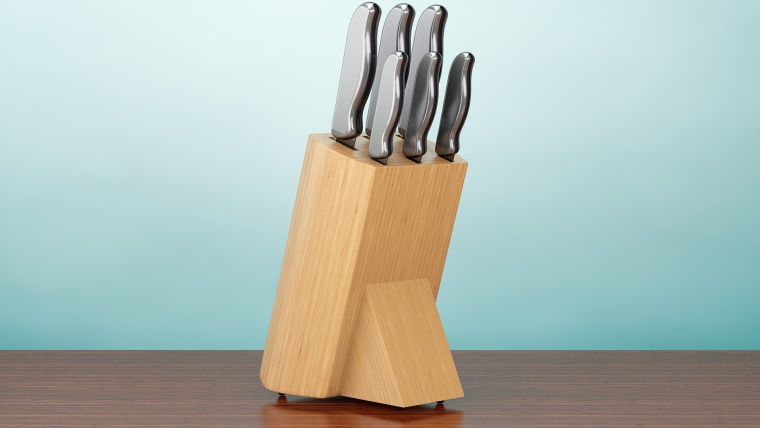Is there anything better than a knife block? It's a safe, convenient and organized way to keep your tools accessible on the kitchen counter or island.
But, chances are, those little slots are holding more than the blade of a knife. According to Allen Rathey, principal of the Healthy Facilities Institute, those openings can become a breeding ground for bacteria. Yuck!
To keep knives ready for use, clean the block regularly — about once a month if knives are used frequently. Here’s how the pros do it.
How to clean a universal knife block
Step 1: Shake out the crumbs
First, remove the knives and turn the knife block upside down to shake out crumbs that may have collected inside. It may help to tap the underside with a small hammer to loosen debris. A large pipe cleaner may also help dislodge anything that's stuck to the bottom. This is an important step because crumbs will be harder to remove once they’re wet.
Step 2: Wash the knife block
Hand wash the block in hot, soapy water, cleaning the slots with a small brush, such as a baby bottle brush.
Rinse well, then sanitize with a mild bleach solution (1 tablespoon of bleach to every gallon of water). Allow the solution to soak for one minute, then rinse the block and slots thoroughly.
For a green-cleaning alternative: Substitute bleach and clean knife block with vinegar (undiluted) or hydrogen peroxide instead. Rinse well.
Step 3: Dry the knife block thoroughly
Dry the block upside down on a clean surface. Don't skip this step! Reinserting tools into the block before it is completely dry can trap water and promote the growth of bacteria, which is exactly what you're trying to avoid. If you're in a rush, try a hair dryer or electric fan to speed up the process.
To keep mold and bacteria from building up in the block, make sure the entire knife — blade and handle — is clean and completely dry before inserting them into the slots.
Note: According to Rathey, bacteria in knife blocks can develop a protective biofilm that makes them resistant to traditional cleaning methods. Because of the difficulty in cleaning knife blocks thoroughly, he advises storing knives in a breathable knife bag (or a drawer) with protective sleeves for each knife.
If you're wondering, specifically, how do you clean a bristle knife block, how to clean a Kapoosh knife block or how to manage a self-cleaning knife block, check the product manual for guidance.
Using interviews with specialists, online reviews and personal experience, TODAY editors, writers and experts take care to recommend items we really like and hope you’ll enjoy! TODAY does have affiliate relationships with various online retailers. So, while every product is independently selected, if you buy something through our links, we may get a small share of the revenue.
This article was originally published on Oct. 2, 2017.



